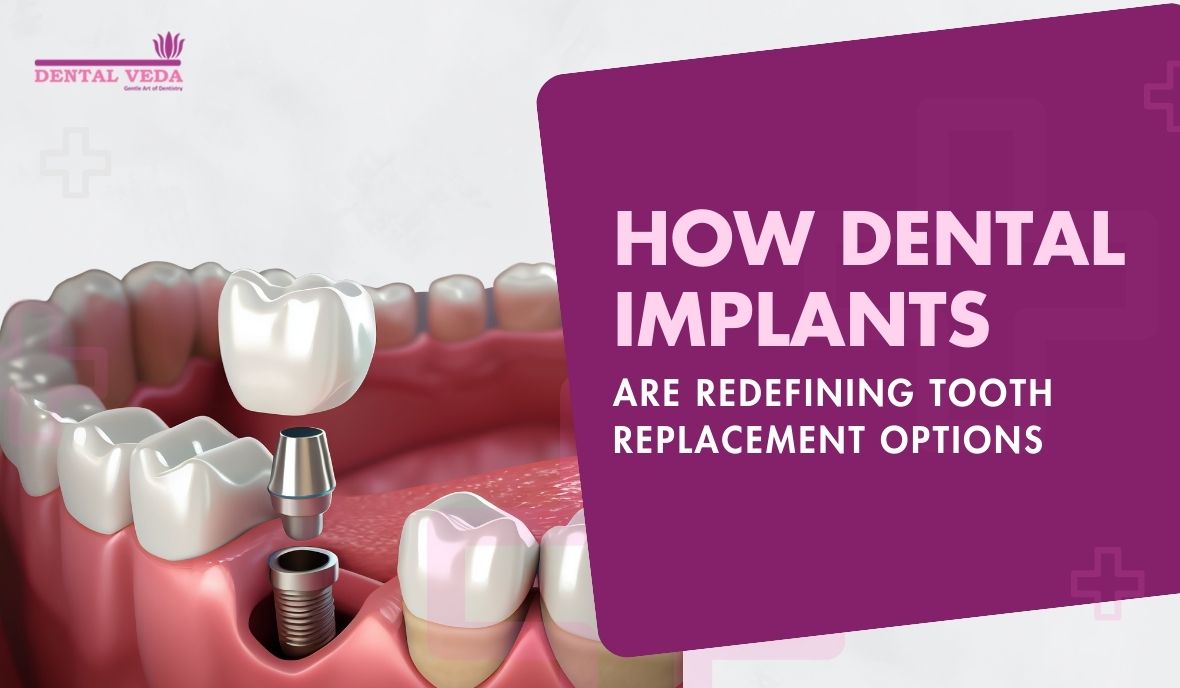Dental implants, a groundbreaking innovation in modern dentistry, represent a revolutionary solution for individuals facing tooth loss. These implants serve as artificial tooth roots, providing a sturdy foundation for replacement teeth, thereby restoring functionality and aesthetics to smiles.
Imagine dental implants as tiny titanium posts surgically positioned into the jawbone beneath the gums. These posts act as anchors, firmly holding artificial teeth or dental prosthetics in place. Unlike traditional bridges or dentures, which rest on the gums or adjacent teeth, dental implants offer a more secure, natural-feeling solution that mimics the structure and function of natural teeth.
Significance of Tooth Replacement
The significance of tooth replacement extends far beyond mere aesthetics. Beyond restoring a beautiful smile, dental implants play a pivotal role in maintaining oral health and preserving facial structure. When teeth are lost, the surrounding bone may begin to deteriorate, leading to potential changes in facial shape and structure. Dental implants help prevent bone loss and maintain the integrity of the jawbone, ensuring a healthier and more youthful facial appearance.
Moreover, missing teeth can significantly impact everyday activities such as chewing, speaking, and even self-confidence. Dental implants not only restore the ability to bite and chew comfortably but also alleviate speech difficulties and boost self-esteem by recreating a natural and complete smile.
Understanding Dental Implants: A Modern Solution to Tooth Loss
Dental implants represent a remarkable advancement in dental technology, offering a permanent and natural-looking solution for replacing missing teeth. Let us delve deeper into the world of dental implants to understand their procedure, types, and the materials involved.
Explanation of Dental Implant Procedure
The dental implant procedure is a meticulously planned and precise process that begins with a comprehensive examination and treatment plan tailored to the patient unique needs. It typically involves several stages:
-
- Assessment and Planning:
A thorough evaluation of oral health, including X-rays, scans, and impressions, helps in planning the implant placement.
-
- Implant Placement:
During a minor surgical procedure, the implant, usually made of biocompatible titanium, is precisely positioned into the jawbone beneath the gums.
-
- Osseointegration:
Over the following weeks or months, the implant fuses with the jawbone through a natural process called osseointegration, providing a stable foundation.
-
- Abutment Placement:
Once the implant has integrated with the jawbone, an abutment—a connector post—is attached to the implant, protruding above the gumline.
-
- Restoration:
Finally, a custom-made crown, bridge, or denture is securely attached to the abutment, completing the restoration and creating a functional and aesthetically pleasing smile.
Types of Dental Implants (Endosteal vs. Subperiosteal)
There are primarily two types of dental implants:
-
- Endosteal Implants:
These are the most common type of implants and involve placing the implant directly into the jawbone. They resemble small screws or cylinders and provide a strong and stable foundation for artificial teeth.
-
- Subperiosteal Implants:
This less common type is placed on or above the jawbone, beneath the gum tissue. They are ideal for patients with shallow jawbones or those unable to undergo a bone augmentation procedure.
Materials Used in Implants
The materials used in dental implants are crucial for their success and longevity. Titanium is the primary material employed due to its exceptional biocompatibility, strength, and ability to fuse with bone during osseointegration. Additionally, some implants feature titanium alloy or zirconia, offering alternatives based on specific patient needs and preferences.
These materials ensure the implants are durable, resistant to corrosion, and capable of withstanding the considerable forces involved in biting and chewing.
Advantages of Dental Implants Over Traditional Solutions
Dental implants stand as a modern marvel in tooth replacement, offering a multitude of advantages that surpass traditional options like dentures and bridges. Let us delve into these advantages through a comparative analysis:
Comparative Analysis with Dentures and Bridges
While dentures and bridges have been longstanding solutions for tooth replacement, dental implants outshine them in several aspects:
-
- Stability and Comfort:
Dental implants, unlike removable dentures, are securely anchored into the jawbone, eliminating concerns about slippage or discomfort while eating or speaking.
-
- Natural Feel and Aesthetics:
Implants closely mimic natural teeth, providing a more lifelike appearance and preserving the natural contours of the face, unlike bridges that rely on adjacent teeth for support.
-
- Longevity and Maintenance:
Dental implants boast exceptional durability and can last a lifetime with proper care, while dentures and bridges might require frequent adjustments or replacements over time.
Durability and Longevity
One of the most notable advantages of dental implants is their remarkable durability and longevity:
- Dental implants, made of sturdy and biocompatible materials like titanium, integrate with the jawbone, providing a robust foundation that can withstand the forces of biting and chewing, akin to natural teeth.
- Unlike dentures or bridges that may experience wear and tear, implants are resistant to decay and do not rely on neighboring teeth for support, ensuring their stability and functionality for many years.
Preservation of Jawbone Health
The preservation of jawbone health is a pivotal advantage offered by dental implants:
- When a tooth is lost, the underlying jawbone may start to deteriorate due to lack of stimulation. Dental implants, by acting as artificial tooth roots, stimulate the jawbone during chewing, preventing bone loss and maintaining its strength and density.
- In contrast, dentures and bridges do not stimulate the jawbone, potentially leading to bone resorption over time, which can alter facial appearance and compromise the integrity of neighboring teeth.
Healing Process and Success Rates of Dental Implants
Understanding the healing process and success rates of dental implants is crucial in appreciating their effectiveness as a long-term tooth replacement solution.
Healing Timeline After Implant Surgery
The healing timeline following implant surgery is a carefully monitored and gradual process:
-
- Immediate Post-Surgery:
Initially, mild discomfort or swelling may be experienced, typical after any surgical procedure. Pain medication and proper care aid in managing these symptoms.
-
- Osseointegration Phase:
Over the subsequent weeks to months, the crucial phase of osseointegration occurs. The implant gradually fuses with the jawbone, forming a sturdy and stable foundation for the artificial tooth or prosthetic.
-
- Prosthetic Placement:
Once the implant has fully integrated with the bone, the final step involves attaching the abutment and prosthetic tooth or restoration, completing the process.
-
- Healing and Adaptation:
Patients typically adapt well during the healing phase, gradually regaining normal functionality and experiencing increased comfort and stability over time.
Factors Affecting Success Rates
Several factors influence the success rates of dental implants:
-
- Bone Quality and Quantity:
Sufficient jawbone volume and density are essential for successful implant placement. Bone grafts may be required if the bone is insufficient.
-
- Overall Health and Lifestyle Habits:
Factors like smoking, certain medical conditions, and poor oral hygiene can impact healing and increase the risk of implant failure.
-
- Surgical Technique and Expertise:
The skill and precision of the dental surgeon play a significant role in ensuring proper implant placement and reducing the risk of complications.
-
- Implant Maintenance:
Regular oral hygiene practices and routine dental check-ups are crucial for implant success, preventing issues like peri-implantitis or infection.
Aesthetics and Functionality of Dental Implants: Redefining Natural Smile Restoration
The allure of dental implants goes beyond mere tooth replacement—it is about reviving natural aesthetics and restoring optimal functionality, instilling confidence and comfort in every smile.
Natural Appearance and Feel of Dental Implants
Dental implants stand as the pinnacle of mimicking natural teeth in both appearance and sensation:
-
- Seamless Integration:
Implants seamlessly blend with the existing dental structure, providing a remarkably natural look that complements the surrounding teeth.
-
- Texture and Color Matching:
The prosthetic teeth, custom-made to match the shade and shape of natural teeth, ensure a harmonious and indistinguishable integration within the smile.
-
- Feel and Comfort:
Unlike traditional dentures, implants feel incredibly natural, offering comfort and stability akin to natural teeth due to their secure attachment to the jawbone.
Restoration of Bite Functionality
The functionality that dental implants restore goes beyond aesthetics, profoundly impacting daily life:
-
- Chewing Ability:
Implants offer a robust chewing function, allowing individuals to enjoy their favorite foods without constraints or discomfort, similar to natural teeth.
-
- Enhanced Bite Strength:
With their firm anchorage in the jawbone, implants restore bite strength, empowering individuals to bite and chew with confidence and efficiency.
-
- Stability and Durability:
Unlike removable dentures that may slip or move during chewing, implants provide stability, enabling individuals to bite and chew with consistency and ease.
Enhanced Speech and Confidence
The impact of dental implants extends beyond functionality, elevating speech and self-assurance:
-
- Improved Speech Clarity:
Missing teeth can affect speech clarity. Dental implants restore proper pronunciation and articulation, enhancing overall speech quality.
-
- Boosted Self-Confidence:
The restoration of a complete smile with implants boosts self-esteem, encouraging individuals to socialize, smile freely, and feel more confident in their appearance.
-
- Freedom and Assurance:
Unlike removable dentures that require adhesive and may cause embarrassment, implants offer the freedom to speak, laugh, and eat without worry.
Final Thoughts on the Role of Implants in Modern Dentistry
Dental implants are more than just prosthetics; they symbolize a revolution in restoring not just teeth but also confidence, comfort, and quality of life. Their transformative impact extends far beyond the oral cavity, nurturing smiles that radiate with assurance and vitality.
As technology continues to advance and innovation knows no bounds, the future of dental implants holds promises of further refinement, precision, and accessibility. Embracing these advancements ensures a future where dental implants continue to pave the way for enhanced oral health, leaving an indelible mark on the canvas of modern dentistry.
If you are looking for the best dentist in Gurgaon, well look no further. We are the best dental clinic in Gurgaon.


